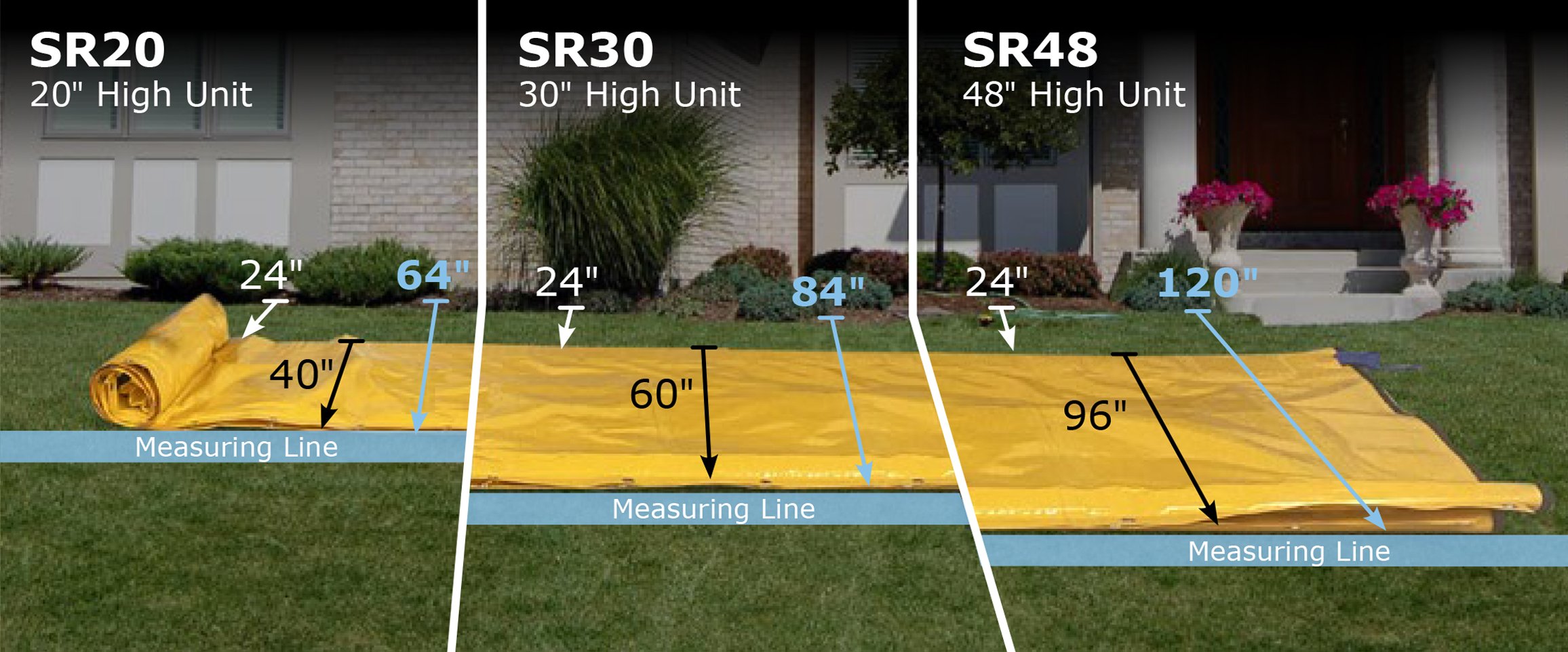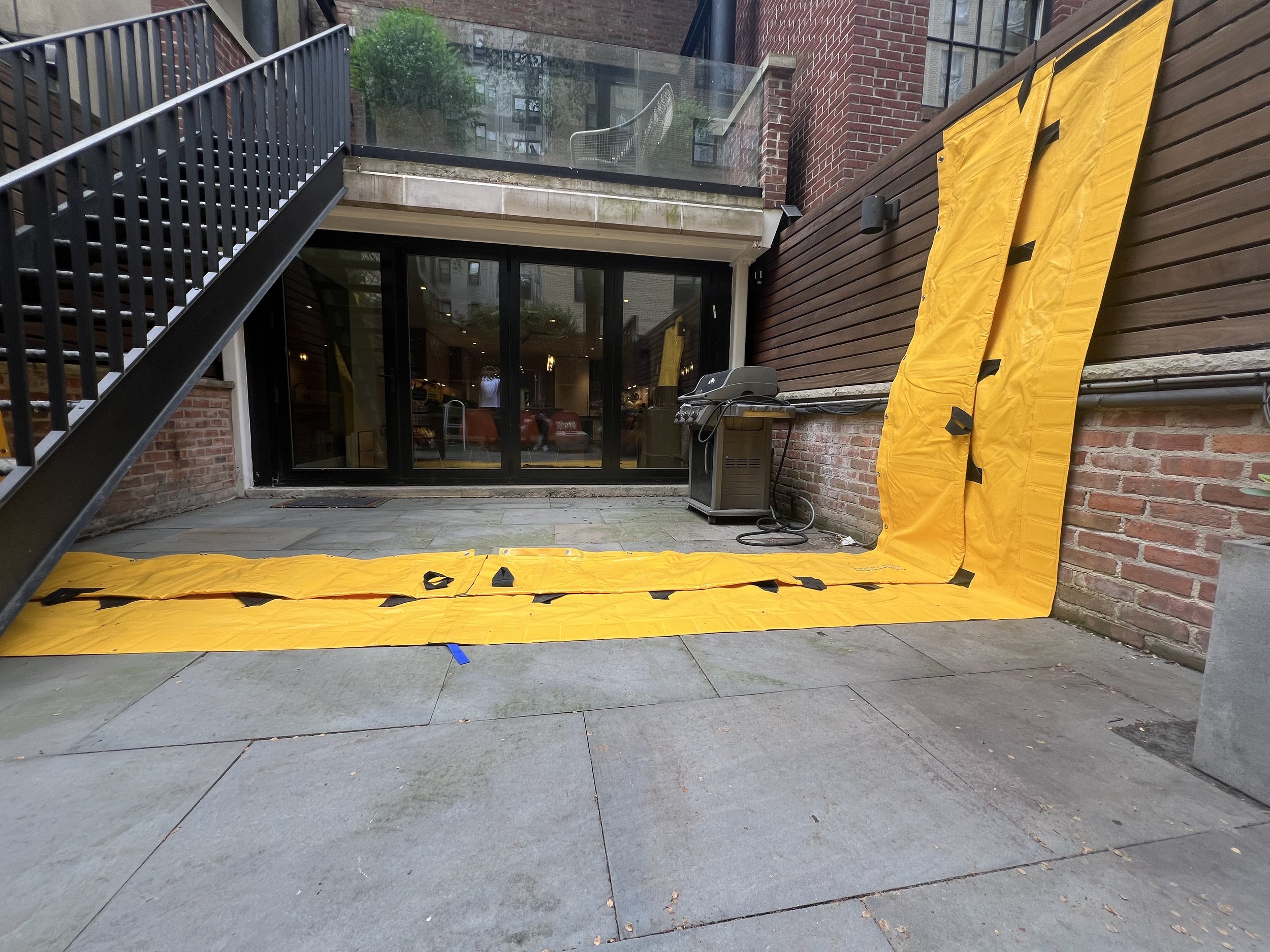
Installation Instructions
HOW TO MEASURE YOUR PROPERTY
Evaluating your property for the Stingray™ Self Rising Water Dam system involves several important considerations to ensure effective flood protection. Here are the key factors to consider:
Property Elevation and Topography:
Assess the elevation of your property relative to nearby water sources (rivers, lakes, ocean) and understand how and where the floodwater is entering the property.
Identify low-lying areas and slopes that might direct water flow towards your property.
Property Size and Measuring:
Measure the perimeter of your property to determine the length of the Stingray system required. You will want to measure the length on the outer edge of the Stingray once unfolded.
Consider any obstructions (trees, sheds, gates, etc) along the boundary that might impact the deployment of the flood control system. The Stingray unit once unfurled must lay flat and clear of obstructions. Potential leakage points will need to be ballasted by sandbags.
You will need 2ft of clearance between the structure you are protecting and the back of the Stingray Water Dam.
Stingray is constructed with a 2:1 height to depth ratio, meaning the depth of the unit will be twice the height of protection. For example, for the 20” height unit, you will need 40” for the unit to lay flat on the ground plus the additional 2ft of clearance between the structure you are protecting and the back of the Stingray Water Dam.
Structural Vulnerabilities:
Inspect buildings and structures for potential weak points where water could infiltrate (doors, windows, foundations).
Plan for the protection of these vulnerable areas using the Stingray and other Garrison Flood protective solutions for added assurance.
Access and Deployment:
Ensure there is adequate space and access for deploying the Stingray system around your property.
Consider how quickly and easily the system can be deployed in the event of a flood warning.
If you have neighboring properties that are close in proximity, consider where the diverted water will flow.
Compatibility with Existing Flood Mitigation:
Evaluate how the Stingray system will integrate with any existing flood barriers, pumps, or other mitigation measures. We recommend sump pumps strategically placed behind the unit to collect water from rain or runoff to pump back over the unit.
Ensure a comprehensive approach to flood protection that covers all potential entry points for water.
Maintenance and Storage:
Plan for the maintenance and regular inspection of the Stingray system to ensure it remains in good working condition.
Determine a suitable storage location that is easily accessible but protected from damage when not in use.
By carefully evaluating these considerations, you can make an informed decision about the suitability and effectiveness of the Stingray™ Self Deploying Water Dam system for your property.
BEFORE DEPLOYMENT
Prepare The Deployment Area:
Clear the deployment area of any debris, clumps of dirt, sod or obstacles, such as large rocks or branches to create level ground against which to seal. Seal mortar joints and other areas that are likely to leak.
Prepare Additional Ballast, Stakes Or Ties If Needed:
While not essential for deployment, additional sandbags or weights can be used for extra stability at transitions between surfaces and on dips to make sure a solid seal is maintained. Stakes may be used to fasten the integrated Stingray loops/straps to the ground for additional stability. Ties can be used to connect the Stingray to fixed walls or structures.
DEPLOYMENT STEPS
Unroll The Barrier:
Unroll the barrier along the length or area to be protected. If a full perimeter is being deployed, unroll sections and position corner pieces at turns. We recommend going well beyond the area to be protected, to ensure that water doesn’t migrate around the barrier into the protected area. For example, if blocking water in a roadway or stream, we recommend extending the Stingray up either curb or riverbank and continuing several feet beyond the area being blocked off.
Position The Barrier:
Place the rolled Stingray at the desired location, ensuring the side with the integrated weights is facing the oncoming water.
Unfold The Flap, Open The Clamshell:
Open any folded flaps of the Stingray so the unit is completely unfolded and unfurled, with the front skirting flat to the ground and without creases. Extend the skirting towards the direction of the expected oncoming water. If possible use straps to assist in holding the top clamshell open as water is rising, or stake the top clamshell in an open position as water enters the chambers within the unit.
Fold PVC Flap Over Velcro
Finish Connecting Units
Line Units Up Next to Each Other
Spread Unit Out Evenly
Velcro Top & Bottom Section
Velcro Units Together
Attach Multiple Units:
Connect additional units, temporarily or permanently, to achieve your desired length of protection using the heavy duty, industrial strength velcro on both ends of the unit. For added durability, you can use the integrated tensioning straps and buckles to affix sections to each other. Sections may be left assembled and rolled or folded as a single run for future deployment. Ensure there are no gaps or openings between the velcro connected sections.
1) Weighted Front Strip - Built in weights keep the unit in place when deployed.
2) Partitions - Reinforced ribbing provides additional strength when water enters the flood dam.
3) Flotation Section - Top Section has a layer of embedded foam to provide flotation, opening the Stingray water pocket.
4) Back Flap with Grommet Holes - Ability to stake down units to keep in place.
5) Non-Slip Bottom - Located on the underside of the unit, the non-slip bottom prevents slipping to provide further stability.
6) Velcro Closure - Easily connect multiple units together with our industrial strength velcro.
Water Enters Barrier Pockets & Opens Into a V-Shape
Stingray Unit is Open & Holding Back Water
Grommet Holes For Extra Stability
Weighted Front Strip
Durable Industrial Velcro Connectors
Open Access Partition Chambers
Unfold Stingray in Desired Location
Water Activation and Features:
The oncoming water will automatically activate the water dam as it fills the ballast compartment and opens the Stingray. As the upper layer rises due to the embedded foam flotation top and water flow, Stingray will begin to hold back water. Incoming water pressure will ballast the Stingray to the ground below, allowing it to hold its position without drifting, even with a significant current. Make sure that corners are sealed and weighted with sandbags to maintain a good seal.
Adding Corner Sections
Making Turns:
There may be areas where corners are needed to go around a structure or property. Stingray has specialized corner pieces that allow for a 90 degree turn.
Set Up:
Stingray Corner units should be positioned where a turn is required. Deploy straight Stingray sections at a 90 degree angle to each other, with the corner piece in the corner between them. Make sure that the weighted edges of the corner piece are facing outwards towards the expected rising water.
Connecting Corner Units:
Similar to the connection of straight Stingray units, corner units connect using the heavy duty, industrial strength velcro on both ends. Additional straps and buckles can be fastened for greater strength.
Optional Steps For Added Stability and Security
Sandbags:
Strategically place sandbags or other weights on top of the Stingray for additional stability, especially on uneven surfaces. We recommend positioning any added sandbags at low points, ensuring a good seal between the front weighted skirting and the ground below. The key is to minimize any leakage below the Stingray.
Stakes and Ties:
There are a number of heavy duty loops and straps at the back and sides of each Stingray unit. These straps can be used to both move and position the Stingray and to stake or otherwise fasten or tie the unit to the ground or to side walls and fixed objects.
Pumps:
In the event there is water collecting behind the barrier from rain or runoff, it is recommended to deploy a sump pump in low lying areas behind the barrier. Water can be pumped and redirected back over the water dam. When a sump pump is used to pump water back over the barrier, consider utilizing an easel or stand to raise the hose over the top of the deployed Stingray barrier, preventing the weight from closing the Stingray.
Breakdown and Storage
After a Flood Event:
Once the flood water recedes, allow the Stingray to drain completely.
Clean and Dry:
Wash the Stingray with clean water and allow it to air dry completely before storage. You may also use blocks or other objects to prop up the Stingray ballast compartments to allow for increased airflow so it can fully dry.
Store Properly:
Store the Stingray in it’s durable bag or in a cool, dry place, away from direct sunlight, for future use.
IMPORTANT NOTES:
For specific deployment recommendations based on your situation (water depth, ground conditions, etc.), consult Garrison to discuss your needs.
Do not place Stingray sections directly against a building as you should leave about 2ft between the structure and the back of the unit.
The Stingray is constructed with a 2:1 length to height ratio, so the available ground clearance should be 2x the height of protection needed.
When surveying your property, take into account any obstructions that may be in the way of laying down the unit properly (trees, shrubs, sheds, etc). Some work may be required to provide a suitable installation environment.
The most vulnerable period is when water levels are low. Seals are enhanced and performance is improved as water rises.
Expect some leakage. Perhaps, as a second line of defense, include sump pumps in low ground behind the water dam and/or additional doorway barriers at openings.
When damming, extend the Stingray up side walls or up river and creek banks. Stake or tie as needed up walls or on sloped ground.






































